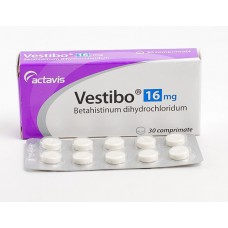Expiration date: 11/2026
Structure and Composition:
Tablets. 1 tablet contains betahistine dihydrochloride 8, 16 or 24 mg
Excipients: povidone K90 MCC lactose monohydrate, colloidal silicon dioxide, crospovidone stearic acid, purified water (not contained in the finished product)
in blister 10 pcs. In the paper cartons 3 blisters.
Description pharmaceutical form:
8 mg Tablets: round flat tablets with bevelled edges, white or nearly white, with marks «B 8" on one side.
16 mg Tablets: Round flat tablets with bevelled edges, white or almost white, labeled «B 16 'on one side and scored on the other side.
Tablets 24 mg: Round biconvex, white or nearly white, scored on one side.
Characteristic:
The synthetic analogue of histamine.
Pharmacokinetics:
It absorbs quickly, binding to plasma proteins - low. Cmax -. 3 hrs almost completely excreted by the kidneys as a metabolite of (2-pyridylacetic acid) for 24 hrs T1 / 2 -. 4.3 hours.
Description of the pharmacological actions:
He is a weak agonist of H1-receptor antagonist and a fairly powerful H3-receptor. Influences on cochlear blood flow and central vestibular system. Action of betahistine comprising: vasodilation in the inner ear (and indirectly through H3- H1-receptor), inhibitory effect on the vestibular nuclei (via H3-receptors) and receptor ampullar pulse activity. Through direct agonistic effects on H1-receptor vessels of the inner ear and precapillary sphincters microvasculature, located in the vascular strip (stria vascularis), as well as indirectly through the H3-receptors improves microcirculation and permeability of the capillaries, and normalizes the endolymph pressure in the labyrinth and the cochlea, increases blood flow in basilar artery. It possesses strong central effect, as H3-receptor antagonist nuclei of the vestibular nerve, normalises neuronal transmission in polysynaptic neurons of the vestibular nuclei in the brainstem level. Indirectly affecting the H3-receptors, increases in the brainstem serotonin, reduces the activity of the vestibular nuclei. It promotes the elimination of violations on the part of the vestibular and cochlear system: reduces the frequency and intensity of vertigo, reduces noise in the ears, improves hearing in the case of its reduction. It stimulates the H1-receptor, so no sedative effect and does not cause drowsiness.
Testimony:
- edema of the inner ear labyrinth
- vestibular and labyrinth disorders: vertigo, noise and pain in the ears, headache, nausea, vomiting, hearing loss vestibular neuritis, labyrinthitis, benign positional vertigo (including after neurosurgical operations), Meniere's disease.
In the combined therapy:
- vertebrobasilar insufficiency
- traumatic encephalopathy
- cerebral atherosclerosis.
Contraindications:
- hypersensitivity
- pheochromocytoma
- bronchial asthma
- gastric ulcer and duodenal ulcer in acute phase
- pregnancy (I term).
Carefully:
- gastric ulcer or duodenal ulcer (history)
- pregnancy (II-III trimester)
- childhood.
Side effect:
Dyspepsia (nausea, vomiting), skin rash, angioedema.
Drug Interactions:
Antihistamines reduce the effect.
Dosage and administration:
Inside, during a meal, not liquid, squeezed small amounts of liquid.
The tablets with a dosage of 16 mg and 8: 8-16 mg 2-4 times a day. Treatment long.
The tablets with a dosage of 24 mg: 1 / 2-1 Table. 2 times a day. The maximum daily dose - 48 mg.
Overdose:
Symptoms include headache, facial flushing, dizziness, tachycardia, decreased blood pressure, bronchospasm.
Special instructions:
The therapeutic effect in a number of cases appears only after a few months of starting treatment.





